Scottish Marine and Freshwater Science Volume 4 Number 5: Modelling of Noise Effects of Operational Offshore Wind Turbines including noise transmission through various foundation types
This report presents modelling of the acoustic output of operational off-shore wind
turbines and its dependence on the type of foundation structure used.
4 Far-field acoustic model
4.1 Beam trace model
The sound field in the marine environment up to 20 km from wind farms consisting of 16 turbines that are founded on jackets, gravity bases and monopiles were modelled. The sound field for each foundation type was modelled using a Gaussian beam trace model (AcTUP, produced by Centre for Marine Science and Technology at Curtin University, Australia). Coherent transmission loss was modelled through two dimensional vertical sections radiating from the wind turbine foundation. To simplify the model it was assumed that there was no surface roughness and that the speed of sound profile was linear.
The acoustic outputs of the near-field models were used as 'source terms' in the far-field model. The source terms were taken as the SPL 30m from the central axis of each near-field model calculated at 5m depth and 5° radial intervals. The sound field of each vertical radial section was calculated by subtracting the transmission loss field from the source term related to the radial section: in this way any directionality of the near-field models is transposed into the far-field analysis. The coordinate system used in the near-field model was followed in the far field model; thus the positive x-direction is taken as the wind direction and it is assumed that all wind turbines in each wind farm was oriented in the same direction.
Each of the resulting 2-dimensional vertical sound fields were compiled using the computer package Matlab, to produce a 3-dimension cylindrical sound field with a diameter of 40 km and a depth of 30 m wind farms founded on monopiles and 50 m for farms founded on jackets and gravity bases. The sound field was modelled in one-third octave frequency bands between 10 and 2000 Hz.
4.2 Geometry and material properties
The two-dimension vertical transmission loss field for monopiles was modelled as 30 m of water, overlaying a 7 m elastic domain that represents sediment which overlies an elastic half space representing the bedrock. The transmission loss fields for the jacket and gravity base were modelled with a 50m water depth overlying 7m of sediment and a bedrock half space. The material properties of the water, sediment and bedrock domains are shown in Table 4-1.
Two wind farm layouts were modelled based on information provided by Marine Scotland:
1. Diamond layout
2. Square layout
These layouts are shown in Figure 4-1. To make comparison between wind farm layouts possible the same spacings were used in the down-wind direction (840 m) and across wind (600 m) for both layouts.
Table 4-1 Material properties used in far-field models
| Speed of Sound | Density | |
|---|---|---|
| m/s | kg/m 3 | |
| Water | 1500 | 1028 |
| Sediment | 1658 | 2020 |
| Bedrock | 2004 | 2350 |
A) Diamond wind farm layout. B) Square wind farm layout
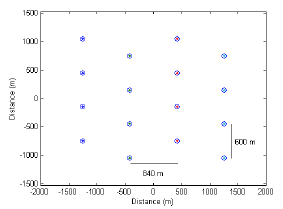

Figure 4-1 - wind farm layouts used to model the far field noise output.
4.3 Results
The modelled sound fields tend to be cylindrical about wind farms, with little variation in sound pressure level with respect to depth. Figure 4-2 shows a vertical cross-section through the sound field in the 16 Hz one-third octave band modelled from a diamond shaped layout; the sound field distribution in this one-third octave band is representative of the other one-third octave bands modelled. Figure 4-2 shows that the SPL is strongly dependent on the horizontal distance from the centre of the wind farm, with only a slight increase in SPL with depth (i.e. almost a perfect cylindrical pattern).
The diamond and square layouts of wind farms were compared and little difference was found in the modelled sound fields ( Figure 4-3). The modelled spectra shown in Figure 4-3 are for wind turbines founded on gravity bases; little difference between diamond and square layouts were found for either jacket or monopile foundations. Given the similarity in the sound fields produced by diamond and square layouts, all discussion of results below are for diamond layout only.

Figure 4-2 - Sound pressure level in a vertical section through an array of 16 wind turbines founded on gravity foundations in a diamond shaped layout. The colour bar represents SPL in dB (re 1 μPa). The vertical white stripes show the positions of wind turbine foundations that the vertical plane intersects. The SPL was modelled for a wind speed of 15 ms -1.
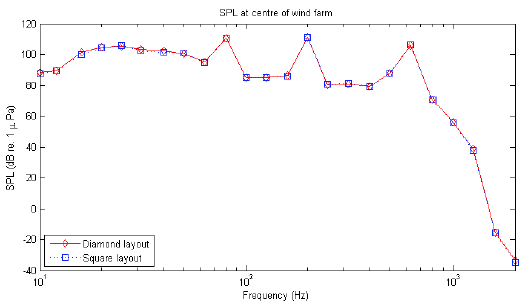
Figure 4-3 - A comparison of sound pressure level in one-third octave bands at the centres of wind farms with diamond and square layouts. The SPL is modelled at the middle of the water column (25m below the surface) for turbines mounted on gravity bases. The spectra were modelled for a wind speed of 15 ms -1.
Spectra of SPL for different foundation types are compared in Figure 4-4. The spectra for each foundation type have peaks in the 25 Hz, 80 Hz, 200 Hz and 630 Hz one-third octave bands. The SPL in the far-field produced by wind turbines founded on monopiles is significantly higher than those founded on gravity bases and jackets below 150 Hz ( Figure 4-4). Gravity bases produce the highest SPL in the 200 Hz and 630 Hz one-third octave bands. Jackets produce the high SPL at frequencies above 800 Hz ( Figure 4-4).
The sound fields produced by the wind farms can be strongly direction. Figure 4-5 shows an example of the directionality of the sound-field in the 20 Hz one-third octave band; the sound fields of all one-third octave bands are shown in Appendix B. The directionality of the sound field varies with frequency and foundation type. The highest SPL tend to be in the plane of the rotor (i.e. cross-wind) (see Appendix B), though in some cases the highest SPL is modelled up- and down-wind of the wind farm (e.g. gravity base at 80 Hz, see Figure 4-6).
The sound produced by wind farms can be masked by the background noise. Masking occurs when the SPL produced by wind turbines is less than the background level. The spectra in Figure 4-4 are shown with the background noise level for sea state 6 ( Figure 2-2). The sound produced by the wind farm mounted on jackets is masked for all frequencies modelled except for the 400 Hz to 800 Hz one-third octave bands. Contours showing where the SPL produced by the wind farm is equal to the background noise level for each one-third octave band are shown in Appendix B, Figure 4-5 and Figure 4-6: the sound produced by the wind farms is effectively masked on the outside of these contours and therefore cannot be heard by marine species. The maximum range at which the wind farm is audible above the background noise is shown in Figure 4-7. At 5 ms -1 the turbines mounted on monopiles and gravity bases are audible at 25, 80 and 200 Hz at least 18 km away, whereas the jacket based turbine are only audible at 630 Hz ( Figure 4-7). At 10 and 15 ms -1 the monopile and gravity bases are audible at least 18 km away at most frequencies below 800 Hz, while the jacket is audible at 250 Hz 10 km away and 630 Hz at least 18 km away ( Figure 4-7).
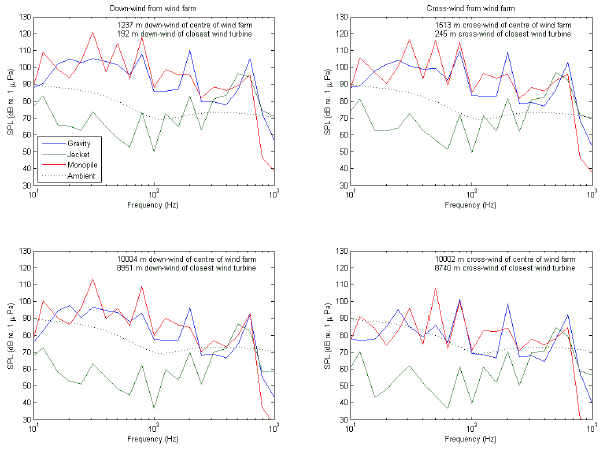
Figure 4-4 - Comparison of SPL in one-third octave band for wind farms founded on gravity bases, jackets and monopiles. The spectra were modelled for a wind speed of 15 ms -1. Spectra approximately 200 m down- and cross-wind from the closest wind turbine are shown as are spectra 10 km down- and cross-wind from the centre of the wind farm. The background SPL is based on the Wenz curve for a sea state 6 and converted to third-octave level.
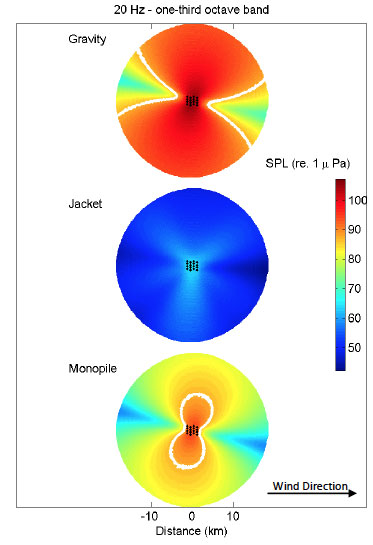
Figure 4-5 - Sound field at 20 Hz in a horizontal section taken at the mid-water depth surrounding wind farms mounted on different foundation types. The black dots show the location of the wind turbines and the white contour is where the sound field is equal to the background level for this one-third octave band; outside of this contour the noise of the wind farm is masked by the background noise.
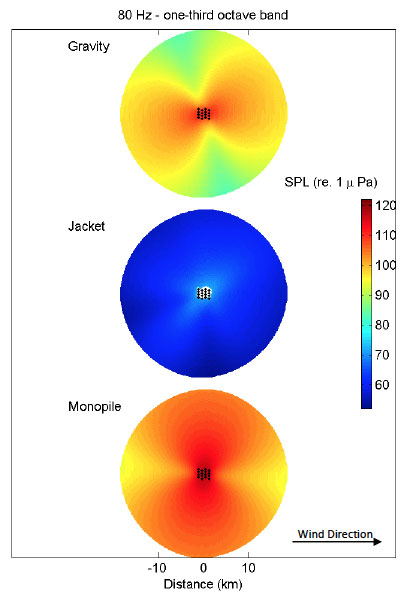
Figure 4-6 - Sound field at 80 Hz in a horizontal section taken at the mid-water depth surrounding wind farms mounted on different foundation types. The gravity base has the highest SPL up- and down-wind of the wind farm, whereas the monopile has the highest SPL in the cross-wind directions.
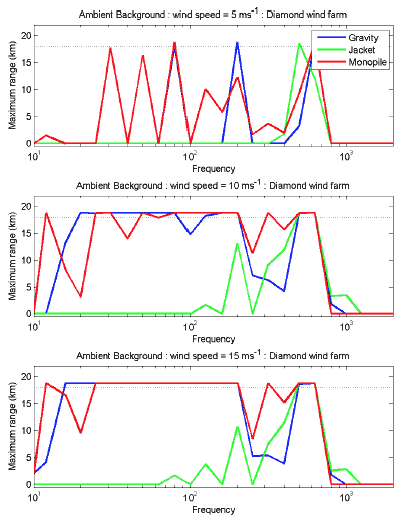
Figure 4-7 - Maximum range from the centre of a diamond shaped wind farm that wind turbines are audible above the background noise as a function of frequency in Hz. Turbines mounted on gravity bases, jackets and monopiles are compared at three different wind speeds. The Wenz curve used for 5 ms -1, 10 ms -1 and 15 ms -1 relate to sea states 2, 4 and 6 respectively converted to one-third octave levels. The dotted black line represents the boundary of the far-field domain that was modelled; at points where the maximum range is above the dotted line represents maximum range lies outside of the modelled domain.
Contact
There is a problem
Thanks for your feedback